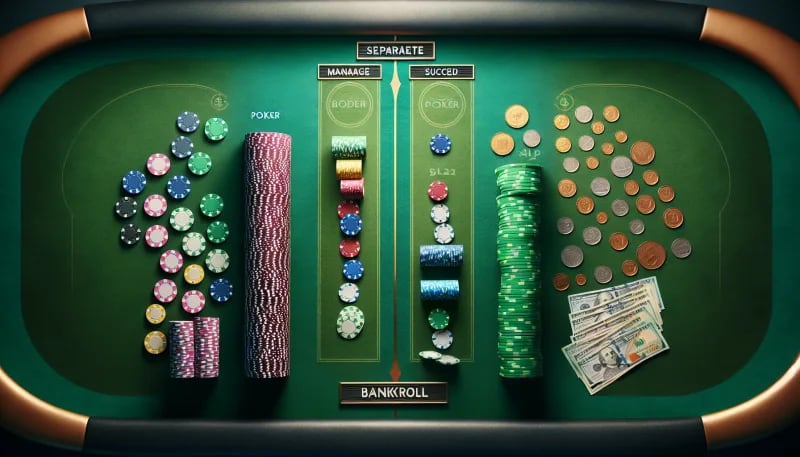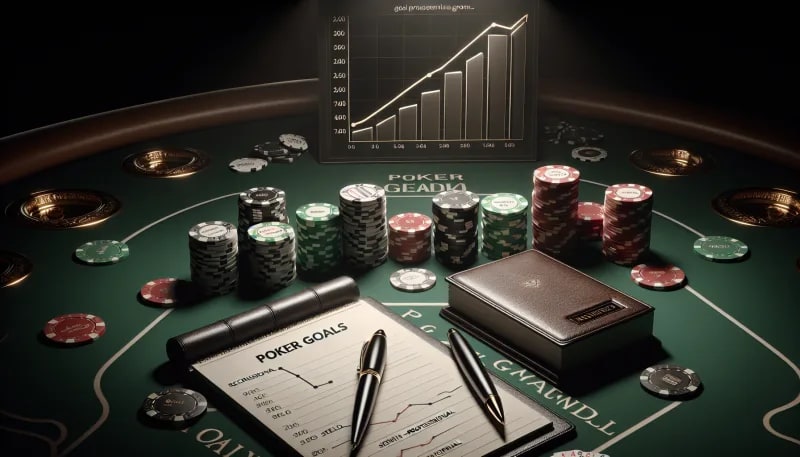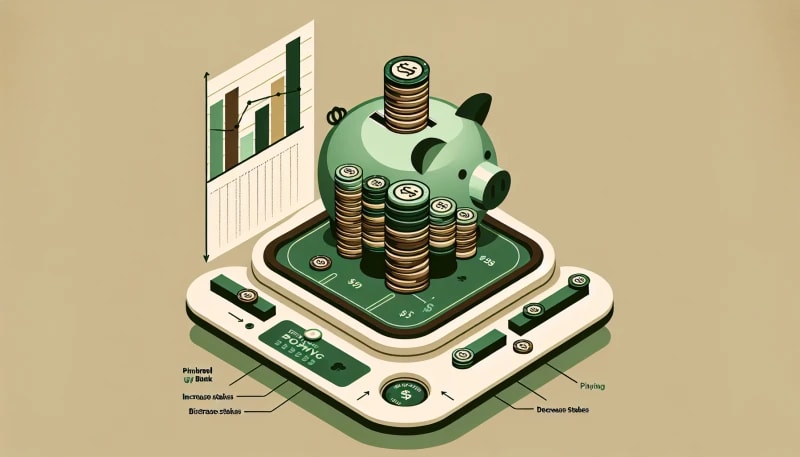Poker Bankroll Management: The Essential Guide for Players at All Levels
Introduction to Bankroll Management
Let's dive right in, shall we? Bankroll management is the cornerstone of a successful poker strategy. Ever wonder why even the most skilled players sometimes end up going bust? It's often not a lack of skill, but a lack of discipline in managing their funds. Yes, you heard that right—discipline.
Imagine playing without limits, a high-stakes game that thrills. But here's the catch: the higher the stakes without regard to bankroll management, the closer you edge toward a cliff. You don’t want to fall off, do you?
Maintaining a healthy bankroll isn’t just about staying in the game. It's about playing smart and ensuring your bets align with your overall financial capacity. Think of it as a safety net that catches you when the cards don't fall your way. It's the buffer between a bad beat and going broke.
For amateurs, mastering this concept early on sets up a foundation for long-term play. After all, poker is a marathon, not a sprint. And for the pros? Well, bankroll management could quite literally make or break their career. It's what separates a sustainable profession from a short-lived hot streak.
Remember, poker is a game of skill over time, but variance can be a cruel beast in the short term. Effective bankroll management tames that beast. Poker pro’s advices are teeming with stories of talented players who didn't heed the call of bankroll prudence—and paid the price.
So, as bankroll management keeps you grounded, let's gear up to dig deeper into the nitty-gritty. How much should you have in your bankroll? Is there a magic number or a one-size-fits-all formula? Stay tuned as we lead into the next section, 'Understanding the Bankroll', where we'll crack open the secrets to a well-managed poker fund, because let's face it: Wouldn't you rather be the player who stays in the game than the one looking in from the outside?
Understanding the Bankroll
Following on from 'Introduction to Bankroll Management', let's dive deeper into what a poker bankroll actually is. Simply put, it’s the money you've set aside exclusively for poker. Think of it as a business's operating capital - this is your tool for making money at the tables, separate from the cash you need for everyday life.
So why is a distinct poker bankroll so crucial? For starters, it shields your personal finances from the variance of the game. Without that separation, a bad run at the tables could mean struggling to pay rent. That's a risk you don't want to take, right?
Having a designated bankroll also gives you a mental edge. There's a certain freedom in knowing the money on the table is reserved for poker. This buffer can prevent emotional decision-making that could arise if you were worried about losing rent money when staring down a tough river decision.
Let’s face it, poker can be a rollercoaster, and you don't want those highs and lows leaking into your ability to enjoy a coffee or a night out. Can you imagine stressing over every chip because it's tied to your grocery budget? That's no way to play.
Think of your bankroll as your ticket to play. It’s your investment in becoming a better player and eventually moving up in stakes. But remember, while it's there to be risked, it's not there to be recklessly squandered. Even the pros recognize this; here's an insightful article about how some of them manage their own bankrolls.
So, how does this all tie into setting poker goals, the next segment? Well, your bankroll is the measuring stick of your progress. Grow it responsibly and your poker goals will come into clearer focus. We’ll look at that next, because when you have clear goals and a solid bankroll, you’re placing yourself on the path to long-term success at the tables.
Setting Your Poker Goals
When we talk about poker success, it's like constructing a building: without a blueprint, how can you rise? I find that setting realistic poker goals acts as that blueprint, with bankroll management as the cornerstone. It's essential to tailor your goals to your playing style and ambitions. Think about it—does a once-a-week player harbor the same aspirations as someone eyeing the World Series of Poker bracelet?
For recreational players, goals often revolve around enjoyment and learning. Perhaps you're aiming to play without dipping into your savings or wanting to become proficient in a new game variation. Your bankroll strategy? Keep it light and fun, only risking disposable income.
Moving to semi-professional players, the objectives shift. You might still be playing for fun, but there's a stronger focus on making a profit. Your goals could be about moving up in stakes responsibly or dedicating time to study sessions. For you, bankroll management becomes a tightrope walk between pushing limits and preserving funds.
Professional players take goal-setting to another tier. You're in this for the long haul, right? That means setting annual earning targets, specifying tournament results, and mastering game theory. Here, bankroll management is your lifeline; it's rigorous and often involves backing or staking to mitigate risk and maximize profitability.
So, ask yourself, where do I fit in? And am I setting goals that align with that vision? If you're chuckling at the thought of a hobby player maintaining a detailed spreadsheet, you likely get my point.
In the transition from Understanding the Bankroll to Bankroll Management Basics, think of goals as the strategic junction. They directly inform how you manage your bankroll—tight and conservative, or aggressive with room for swings. It's not just about choosing a path; it's about paving one that leads to a destination befitting your poker persona.
Remember, whether you're a weekend warrior or grizzled pro, your poker expedition is uniquely yours. Align your goals with your bankroll tactics and watch how they complement each other like a well-shuffled deck. Ready to shuffle up and deal with your financial strategies? Let's dive into the nitty-gritty of bankroll management next.
Bankroll Management Basics
After setting your poker goals, it's essential to talk about the financial fuel behind them: bankroll management. Think of your bankroll as the lifeblood of your poker career. How do you keep it pumping strong?
Buy-ins are your entry tickets to the poker tables. They're a fraction of your bankroll, dictating the games you can afford to play. It's a simple concept to grasp but crucial to adhere to. You wouldn't use your entire savings to buy a car, right? Same principle applies here.
Managing your bankroll isn't just about counting dollars—it's understanding the ebb and flow of the game, known as variance. Yes, skills matter, but luck plays a role too.
Ever hit a losing streak and wondered if it's just bad luck or if you're out of your league? That's variance showing its fickle nature. The key is to have enough in your bankroll to withstand those swings without going bust.
Knowing when to move up or down in stakes is often more art than science. I look for a consistent win-rate over a significant sample of hands or tournaments before leveling up. If the tides turn? No shame in stepping down to regroup and rebuild.
Minimum bankroll requirements can vary, but a good rule of thumb is to have at least 20-30 buy-ins for cash games and at least 50 for tournaments. Lower-stakes players might lean towards the higher end due to increased variance. The truth is, the more cushion, the better.
Curious about deeper strategies for different game formats? Check out Harrington on Hold 'em, an invaluable resource that dives into bankroll tactics for various scenarios.
Are you ready to make moves with money management as your guide? Stay tuned as we navigate into the next segment, 'Risk Assessment and Tolerance', where we'll explore how personal comfort with risk impacts your bankroll decisions.
There you have it, folks. Stick to these bankroll management basics, and you'll set the stage for a successful and sustainable poker journey. Keep those goals realistic, and remember, the size of your bankroll is both a tool and a safety net. Use it wisely.
Risk Assessment and Tolerance
Bankroll management is the backbone of poker success, right? But your approach to bankroll management hinges on a key personal factor: risk tolerance. Ever asked yourself, how comfortable am I with the ups and downs of poker fortunes? Let's dive into assessing that comfort level.
First, evaluate how much you can afford to lose. It's not just about what you're willing to invest; it's about understanding the impact of potential losses on your life outside poker. This is your financial risk tolerance. If losing a session might mean skipping out on essentials, you're playing out of your league.
Now, think about emotional risk tolerance—how does the stress of a downswing affect your mental state? Feeling tilted can cause you to make poor decisions, escalating losses. If you find you're emotionally attached to every pot you play, it might be time to rethink your stakes.
Remember that successful players aren't those who avoid risk, but those who manage it intelligently. Calculated risks are part of the game, but what's calculated for you might be reckless for another. Can you differentiate between a gut instinct and a hasty move?
Here's the balance: play within your means to avoid being burnt out by losses, but be prepared to take strategic opportunities when they arise. Never let fear of loss prevent you from making a move you know to be +EV (expected value). This article from PokerNews helps explain the importance of making +EV decisions.
Remember, the size of your bankroll is directly tied to risk. A larger bankroll absorbs shocks; a smaller one magnifies them. Running too high a risk could mean curtains for your poker career.
What is your long game in poker? If you're here for the long haul, keeping your bankroll thriving is crucial, and that's what we're addressing next with Bankroll Building Strategies. Keep these risk assessment principles in mind, and you'll not only survive but also thrive on the felt.
Bankroll Building Strategies
Building your bankroll is like constructing a house – you need a solid foundation and the right tools. After assessing risks and setting your tolerance levels, let's talk strategy.
When picking your battles, game selection is key. You've got to ask yourself, are you swimming with sharks or fishing in a pond? Find games where you have an edge, and stick to them. This could mean lower-stakes games with less skilled players. More victories equal a thicker wallet.
Taking shots at higher stakes can be tempting. But, do it responsibly. Allocate a small portion of your bankroll to test the waters in higher-stakes games. Think of it as a scout mission; you're there to observe and learn, not conquer (yet). If you lose, it's not a total knockout. Here's a guide that might help you decide when it's time to level up.
Profits – oh, how we love them! But reinvesting them is the real game-changer. Plow a percentage back into your bankroll. It's how you scale up, incrementally but surely. Plus, it safeguards you from dipping into personal funds.
Ever considered a poker coach or training site? That's a strategic investment. A coach can give you insights you might miss on your own. And most top players swear by the continuous learning they facilitate through resources like Run It Once.
Finally, remember the golden rule of bankrolling: never put all your eggs in one basket. It’s about balance. Diversify your game types and stakes, and keep learning.
In the next section 'Recovering from Downswings,' we'll tackle the inevitable – the rough patches. Bankroll building isn't just about the climb; it's also about holding your ground when the terrain gets shaky. Stay tuned for some life-saving strategies.
Recovering from Downswings
Now that we've scaled the ladder of bankroll building strategies, we're ready to face an inevitable rite of passage: downswings. It's not about if they'll come, but when, and how you'll weather the storm. How do you maintain your composure and your bankroll during these testing times?
Roll with the punches. Literally. Your bankroll is your cushion, so don't let it deflate with desperation. When the cards aren't falling your way, it's crucial to tighten the belt. Have you reconsidered your stakes? Dropping down a level is a strategic retreat, granting you room to regroup without bleeding chips.
Emotions can be treacherous allies at the poker table. Ever felt the urge to win it all back with one big hand? That's your emotions talking, not your strategy. Take a deep breath. Chasing losses is a gamble with your hard-earned bankroll; it’s akin to digging deeper into the hole you're trying to escape. It’s better to step back than to fall back.
And while stepping back, hit the books: articles, forums, training sites like Upswing Poker offer a wealth of knowledge. Are you reviewing your hand histories? That's where your comeback story begins. You'll often find the leaks in your game that went unnoticed during the heat of the moment. Fixing those can turn the tides in your favor.
Sometimes the issue isn't strategic—it's psychological. Keep a journal. Jot down how you felt during sessions, your thoughts, your doubts. Over time, patterns emerge. Are you playing well but still losing, or is tilt compromising your decisions?
Each day is a fresh shuffle. Remind yourself: poker is a long-term game. How will you apply these lessons to enhance your approach when moving towards advanced bankroll management techniques? Remember, downswings test not just your skills, but your grit. Will you fold under pressure, or will you use this as a catalyst for growth?
Advanced Bankroll Management Techniques
After grappling with downswings, you know that bouncing back isn't just about mental grit—it's about having the right financial strategies in place. But how do you take your bankroll management to the next level? Let's dive in.
First things first, do you use poker tracking software? It's a game changer. Programs like Hold'em Manager or PokerTracker go beyond simple win-loss records. These tools can help you analyze your hand histories, understand your winnings per game type, and recognize patterns you might be missing. The wealth of data at your fingertips is invaluable for tweaking your bankroll strategy.
Next, consider the variance in different games. No two poker tables are the same. Some are filled with sharks; others are splashing-fests. As an experienced player, I don't need to tell you that your bankroll needs to be larger for high variance games—think PLO or high stakes MTTs. So, what's your comfort level with variance? Adjust your bankroll accordingly.
ROI, or return on investment, is another term you've certainly heard before. But are you actively calculating it for tournaments? Tournament play is a beast of its own. With larger fields, the variance skyrockets. By knowing your ROI, you can make informed decisions about buy-ins and expected value over the long haul. Dolling out buy-ins without this knowledge? You might as well be flying blind.
Finally, let's talk player pools. Recognizing who’s at your table and adapting is crucial. If you're taking notes and tracking player habits (which you should), you’ll have a noticeable edge. Smaller player pools can be more predictable – you know your opponents’ tendencies. Larger, more anonymous pools? They require a buffer in your bankroll for the unexpected.
Remember, this isn’t just about surviving in the poker ecosystem—it's about thriving. Are you maximizing every dollar of your bankroll? If not, it’s time to get serious. Because when the next downswing hits—and it will—you'll want to be as ready as ever.








